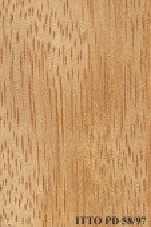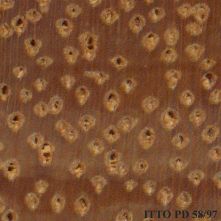
GOMBé (Didelotia brevipaniculata)
Trade Name
Gombé
Scientific Name
Didelotia brevipaniculata J.Leon.
Family
LEGUMINOSAE
Common Names
Timba (Sierra Leone); Anchoung (Guinea-Bissau); Broutou (Côte d`Ivoire); Angok (Gabon); Ekop-gombé (Cameroon); Ekop zing (Cameroon); Bondu (Liberia)
Scientific Name Synonyms
Toubaouate brevipaniculata; Toubaouate brevipaniculata (Leonard) Aubrev. & Pellegr.
Description Of The Tree
Botanical Description
The tree may reach a height of more than 50 m. The bole is clear to 26 m, straight and cylindrical. The trunk is usually about 70 to 100 cm but may reach up to 170 cm. It is swollen at the base.
Natural Habitat
Didelotia brevipaniculata is found in evergreen rain forests.
Natural Distribution
West Africa.
Wood Identification
Anatomic Description Of Wood
Wood diffuse porous. Occasionally vessels exclusively solitary (over 90%). Tangential diameter of vessel lumina 200 micras or more (large). Vestured pits. Vessels per mm2 less than 6 (rare). Simple perforation plates. Vessel-ray pits similar to intervessel pits Occasionally axial parenchyma in marginal or in seemingly marginal bands. Paratracheal axial parenchyma scanty and/or vasicentric. Axial parenchyma lozenge-aliform. Prismatic crystals in chambered axial parenchyma cells and/or in fibers. 3 to 4 cells per pare Rays more than 10 per mm (abundant). Rays and/or axial elements irregularly storied. Rays non-storied. Rays exclusively uniseriate. Homogeneous rays and/or sub-homogeneous rays (all ray cells procumbent). Body ray cells procumbent with one row of upright and/o Non-septate fibers. Fibers with simple to minutely bordered pits.
-
 Wood Macro Photo Tangential Plane
Wood Macro Photo Tangential Plane
-
 Wood Micro Photo Of Transversal Section
Wood Micro Photo Of Transversal Section
Availability
Cites Status
Unrestricted
General Wood Description
Color
The sapwood is red-brown to pale brown, it has a thickness of 5 to 7.5 cm. The heartwood is pale red-brown with a greenish tint near the sapwood, it is clearly demarcated.
COLOR INDEX (1=Black, 7=Light yellow,white)
5
Grain
Straight or slightly interlocked; grain has no particular influence on drying, machining and finishing qualities.
Texture
A coarse texture is reported in this species.
Luster
The wood surface is described as low in luster.
Natural Durability
Slightly durable to decay. This species needs preservative treatment for uses with risks of occasional re-humidification. It is not suited for uses with risks of permanent or long-lasting humidification. Sensible to termites attack. The heartwood is resistant
Natural durability index (1= Very high durability, 7=Vey low durability)
6
Internal Growth Stresses
Residual stresses are reported to be absent.
Resistance To Impregnation
Difficult to treat with only a low penetration of the preservative products.
Wood Physical Properties
Basic Density or Specific Gravity (O.D. weight/vol. green) (g/cm³)
0.61
Air-dry Density (Weight and volume at 12%MC) (g/cm³)
0.68
Total shrinkage Tangential (Saturated to 0%MC) (%)
9.1
Total shrinkage Radial (Saturated to 0%MC) (%)
3.7
Drying Defects
Ease of Drying: Keranji dries moderately slowly. Boards 15 mm thick take 2 months to air dry. Drying Defects: During drying the wood is liable to split, a tendency to moderate surface, end checking, and to slight warping is also reported. Warping and checking can be prevented by quarter-cut sawing and slow and careful seasoning techniques. Kiln Schedules: Schedule proposed for Keranji.
Recommended Dry Kiln Schedule
FR-7
Dimensional stability ratio (Total Tangential Shrinkage %/Total Radial Shrinkage %)
2.5
Wood Chemical Properties
Wood Mechanical Properties
Bending Strength (MOR),12%MC (kgf/cm²)
842
Stiffness (MOE) 12%MC (kgf/cm²)
109123
Compression parallel to fiber 12%MC (kgf/cm²)
534
Compression perpendicular to fiber 12%MC (kgf/cm²)
68
Shear strength radial 12%MC (kgf/cm²)
69
Janka hardness (side) 12%MC (kgf)
573
Janka hardness (end grain) 12%MC (kgf)
672
Workability
Sawing
It is easy to saw.
Rotary Veneer Cutting
Suitable for slicing, also suitable for peeling if treated.
Sliced Veneer
Suitable for slicing, also suitable for peeling if treated.
Blunting Effect
Slight blunting effect; ordinary tools can be used for sawing and machining.
Machining
Machining of this species is reportedly easy.
Planing
Moderately easy; tools must be cautiously sharpened.
Moulding
Easy; no particular problems.
Boring
Easy; no particular problems.
Mortising
Easy; no particular problems.
Nailing
Pre-boring is necessary.
Gluing
Glues well if basic gluing technical rules are followed.
Sanding
Easy to perform; it gives good results.
Polishing
Needs pre-coating.
Steam Bending
This species can be used for steam bending.
Response To Hand Tools
No particular problems.
REFERENCED USES
End Uses Summary
HOUSING GENERAL, beams, joists, boards, flooring, parquet, frames, steps, panelling, fittings, shutter boards, FURNITURE AND CABINETS, common furniture, PLYWOOD AND VENEER, faces, Decorative veneer, PACKING, heavy packing, pallets, CONTAINERS, truck bodies, truck flooring
General Housing
- 10 - Silica in Timbers
Beams
- 11 - Prospect: The wood database
Joists
- 12 - Tropical timbers of the world. Part I-Tropical American Species
Boards
- 13 - Dry kiln schedules for commercial woods. Temperate and tropical. Section III. Latin American (Mexico, Central, and South America) Woods–Conventional Temperatures
Flooring
- 14 - Handbook of Hardwoods
Parquet
- 15 - Empire Timbers
Frames
- 16 - Woods of the World
Steps
- 17 - Tree Conservation Database
Paneling
- 18 - W3TROPICOS Missouri Botanical Garden
Fittings
- 19 - Silica in Timbers
Shutter Boards
- 20 - Prospect: The wood database
Furniture Cabinets
- 21 - Tropical timbers of the world. Part III-Southeast Asian and Oceanian Species.
Furniture, Common
- 23 - Handbook of Hardwoods
Panels, Veneers
- 25 - Directory of Timber Trade Malaysia
Faces
- 26 - Annual Review and Assessment of the World Timber Situation 1998-ITTO
Decorative veneer
- 28 - Ministry of Agriculture, Fisheries & Forest of Fiji
Packing
- 45 - Recopilación y Análisis de Estudios Tecnológicos de Maderas Peruanas
Heavy Packing
- 47 - Arvores Brasileiras
Pallets
- 48 - The strength properties of timbers
Truck Body
- 53 - Timbers of the New World
Truck Flooring
- 54 - Bulletin of the Government Forest Experiment Station N.157: Identification of Tropical Woods
Please Provide Information To View Producer Information